Life has been hectic the last couple of months. We've shifted into release mode on the library I maintain, and we have a deadline this week, with a release in December. That combined with the shift to Standard Time means I drive to and from work in the dark. This last week offered a EAA chapter meeting, an airpark board meeting, driving Mom to a doctors appointment, etc..
I survived the worst layoff yet in my 19 year career at AMD. Gone are my direct supervisor David Huebel (my first boss out of college) and Doug Paulson, who I (well, me and Ricky) hired out of college, and who was a very productive engineer on my project. I'm quite upset to lose both of these guys. So now it's just me here in Austin. It's been hard to concentrate the last couple of weeks, and we lost about a week of productivity because of this layoff. Since I'm trying to stay roughly on schedule (with some loss of scope), now I get to put in 11 hour days.
But this blog is about the RV-9A, and now I'll get to the main subject. The previous week I finished up an Instrument Proficiency Check with George Farris. I still need to fly a bunch more approaches for practice before I'm really sharp, and my personal minimums are still Marginal VFR right now. But at least I should soon be ready to file IFR and punch through a typical shallow cloud layer with a 1000 foot ceiling (the 3R9 takeoff mininmums), which I can now do legally.
Cav now has over 200 hours and I am closing in on 500 hours. Along with staying instrument current and building proficiency, I'm thinking about getting a tailwheel endorsement, and then starting on a commercial certificate. On Thursday this week I took a long lunch and took Braga flying. He had been up with me once several years ago in one of George's 172's. I plan on doing more of these, with 2 or 3 people
This weekend I changed the oil, and went for two short flights. It was fairly windy and not the best flying conditions, but it wasn't as bad as I thought it would be. Now Cav is ready to do some serious flying. I might try to go to Pagosa Springs. Maybe I can get in a trip to Virginia over the Christmas break.
Van's RV-9A in Aurora
Sunday, November 11, 2012
Saturday, October 13, 2012
Haven't flown much in the month since the annual and trailing edge work was finished. Weather has been kind of crummy, such as today, which explains why I'm typing this in instead of returning from somewhere.
I did take up a couple of passengers, Brenda and Debbie.
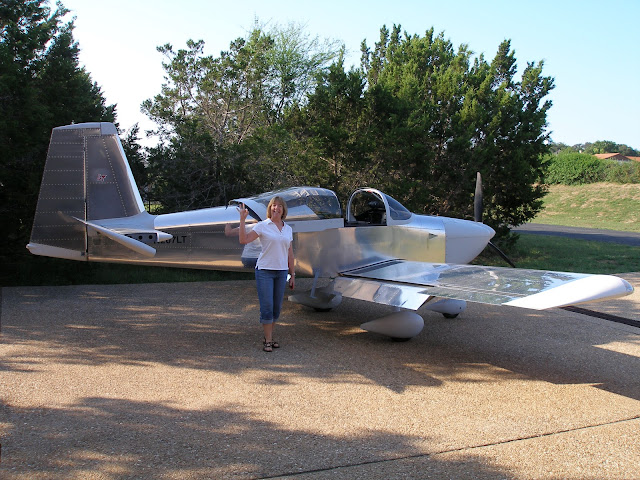

Flew down to Galveston and visited the flight museum. Moody Gardens is right at the airport, so this is a possible destination with Lynne.
Finally, I flew out of Lakeway at dusk one evening to re-establish night currency. I flew a VFR ILS 13 at San Marcos, then a landing and takeoff in Junction, a landing and takeoff in Kerrville, and two landings and a takeoff in Fredricksburg. It was a perfect evening, the plane was flying on polished rails.
Leaving San Marcos, once established at 4500 feet I looked up and saw a V of birds about 500 feet higher. Another 10 minutes and it would be too dark to see them. That's right, large migrating birds at 5000 feet, at night! October is good time of year to fly, but there are risks.
One other item to add - the autopilot saga. The A/P pitch axis was acting up on the way home from Oshkosh. I removed the controller and sent it in, when I got it back it was completely refurbished. But it didn't fix the problem. I spent some time verifying the pitch servo cable. Perfectly fine. So out came the pitch servo and off it went to Arkansas to True Trak. They refurbised it (the amplifier had failed) and I got it back and installed on September 18. I'm happy to report that the autopilot now works perfectly. And it's brand new!
I did take up a couple of passengers, Brenda and Debbie.
Flew down to Galveston and visited the flight museum. Moody Gardens is right at the airport, so this is a possible destination with Lynne.
Finally, I flew out of Lakeway at dusk one evening to re-establish night currency. I flew a VFR ILS 13 at San Marcos, then a landing and takeoff in Junction, a landing and takeoff in Kerrville, and two landings and a takeoff in Fredricksburg. It was a perfect evening, the plane was flying on polished rails.
Leaving San Marcos, once established at 4500 feet I looked up and saw a V of birds about 500 feet higher. Another 10 minutes and it would be too dark to see them. That's right, large migrating birds at 5000 feet, at night! October is good time of year to fly, but there are risks.
One other item to add - the autopilot saga. The A/P pitch axis was acting up on the way home from Oshkosh. I removed the controller and sent it in, when I got it back it was completely refurbished. But it didn't fix the problem. I spent some time verifying the pitch servo cable. Perfectly fine. So out came the pitch servo and off it went to Arkansas to True Trak. They refurbised it (the amplifier had failed) and I got it back and installed on September 18. I'm happy to report that the autopilot now works perfectly. And it's brand new!
Right wingtip trailing edge
I finally conjured the nerve to break up a good airplane and split the right wingtip trailing edge. With the trailing edge split and the rib removed, I could manipulate the structure as required to get it to line up nicely with the ailerons.
Of course a prerequisite to this work was carefully adjusting the ailerons during the annual inspection using the jigs specified by Van's. I measured and checked three times, so I'm confident this part is right.
After splitting the trailing edge, I mixed up some structural epoxy and flox and clamped the trailing edge in place, with a straight edge to make sure it all lines up properly.
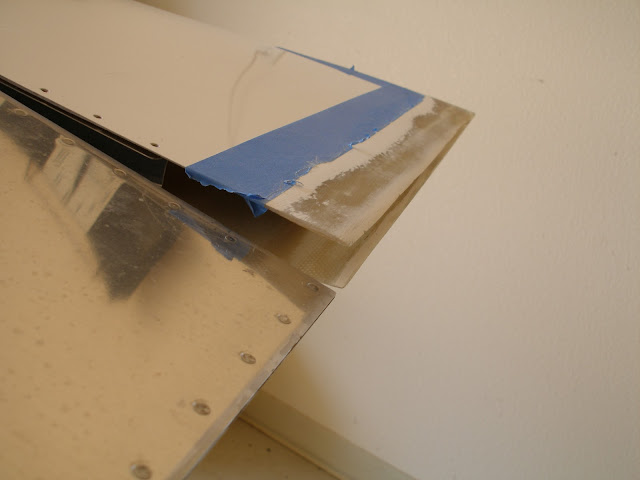
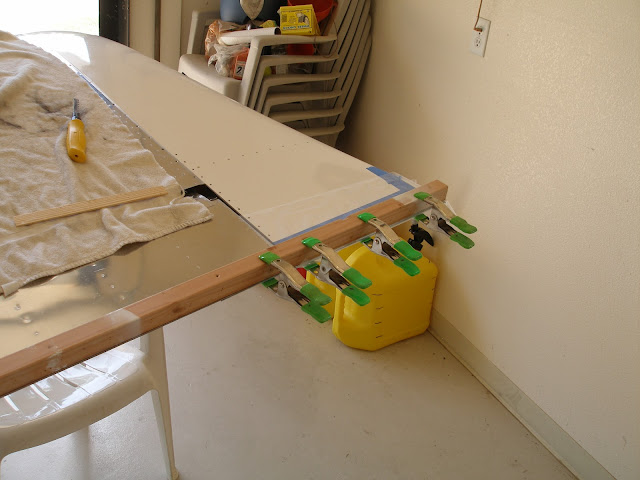
After drying, I had a slight concavity, but the trailing edge is nicely lined up. Next I match drilled the new rib and riveted in back in. Time to go test it out.

I'm typing this up about a month after doing the work, and I was very eager to make the test flight, and then very disappointed when it had absolutely no effect. Double Drats! I moped around for a couple of days, re-read the Van's heavy wing write up. The last step of their analysis is, if all else fails, add a trim wedge. So I made up a styrofoam trim wedge to try out.
I used 3M brand speed tape (well OK, duct tape) and stuck the trim wedge to the bottom of the right aileron. I had tried a trim wedge back in phase one, but it was not big enough. This one apparently is - it completely solved the problem. I tried a slightly smaller wedge, but went back to the first one. Finally Cav flies hands off true, and the aileron trim is actually usefull for trimming out uneven loading.
Best of all, the trim wedge does not affect speed at all. I was afraid that a built in aileron deflection would add drag, but as near as I can tell, it stays pretty close to lined up with the trailing edge in flight, and didn't slow me down a bit.
Of course a prerequisite to this work was carefully adjusting the ailerons during the annual inspection using the jigs specified by Van's. I measured and checked three times, so I'm confident this part is right.
After splitting the trailing edge, I mixed up some structural epoxy and flox and clamped the trailing edge in place, with a straight edge to make sure it all lines up properly.
After drying, I had a slight concavity, but the trailing edge is nicely lined up. Next I match drilled the new rib and riveted in back in. Time to go test it out.
I'm typing this up about a month after doing the work, and I was very eager to make the test flight, and then very disappointed when it had absolutely no effect. Double Drats! I moped around for a couple of days, re-read the Van's heavy wing write up. The last step of their analysis is, if all else fails, add a trim wedge. So I made up a styrofoam trim wedge to try out.
I used 3M brand speed tape (well OK, duct tape) and stuck the trim wedge to the bottom of the right aileron. I had tried a trim wedge back in phase one, but it was not big enough. This one apparently is - it completely solved the problem. I tried a slightly smaller wedge, but went back to the first one. Finally Cav flies hands off true, and the aileron trim is actually usefull for trimming out uneven loading.
Best of all, the trim wedge does not affect speed at all. I was afraid that a built in aileron deflection would add drag, but as near as I can tell, it stays pretty close to lined up with the trailing edge in flight, and didn't slow me down a bit.
Monday, September 3, 2012
Got in an hour flying today. Mainly I just wanted to fly, but I also got a couple of test items done. First, I verified that aileron rigging changes made during the condition inspection did not change the heavy left wing. More on that in a moment. I also put in some more time testing the autopilot. The pitch axis is simply not working, a ground test showed that the pitch servo is not properly controlling the elevator. I do need to rule out problems with the shear pin, but I may need a new servo. Given that the problems happened intermittently, then more frequently, then not working at all, I don't think it's a shear pin problem. A shear pin failure is binary, it works or it doesn't, no gradual failure modes.
Saturday I flew for a short time, then started in on modifying the right wing tip. I did a little bit of gel coat sanding, but I wasn't dressed properly to make a mess with sanding dust. So after flying today, being appropriately dressed as an airplane bum, I removed the wingtip and got after the sanding in earnest. I had masked off the trailing edge and today removed all the gel coat at the very trailing edge. This will make a good foundation for fiberglass layups. Gel coat is not a good foundation, which is why it had to be removed.
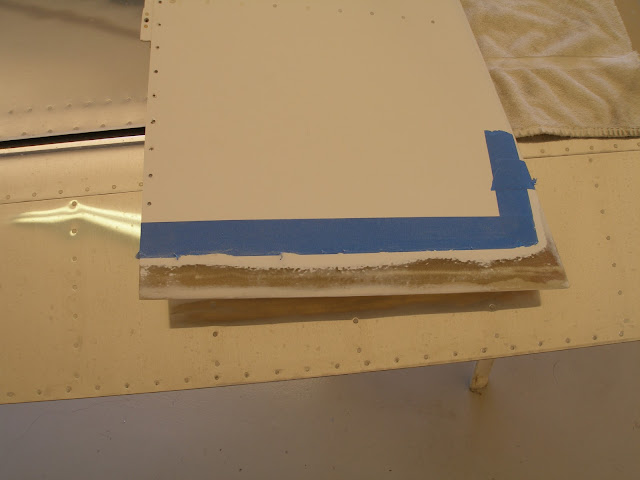
I also started the process of removing the old 916 rib. I drilled through all the rivets, now I have to pop them out and remove the rib.

After that it's time to split the trailing edge, and see how effectively I can get it to line up.
Saturday I flew for a short time, then started in on modifying the right wing tip. I did a little bit of gel coat sanding, but I wasn't dressed properly to make a mess with sanding dust. So after flying today, being appropriately dressed as an airplane bum, I removed the wingtip and got after the sanding in earnest. I had masked off the trailing edge and today removed all the gel coat at the very trailing edge. This will make a good foundation for fiberglass layups. Gel coat is not a good foundation, which is why it had to be removed.
I also started the process of removing the old 916 rib. I drilled through all the rivets, now I have to pop them out and remove the rib.
After that it's time to split the trailing edge, and see how effectively I can get it to line up.
Tuesday, August 28, 2012
Cav has been grounded for a couple of weeks while I do the annual condition inspection. Nearly done with all the items on the list.
One task I've been putting off is shimming the lower engine mounts to raise the front of the engine. This is needed because the mounts have sagged over time so the the prop is about 1/4" low. That messes up alignment of the cowling which was custom fitted before the engine was run. Took an hour or two over three days, but I finally got the hard part of this task done tonight. The extra spacers are in, the bolts are reinstalled, and cotter pins in place. Only an hour of two of work to finish the small stuff that was moved out of the way to make access easier.
I'm also going to work on the right wing tip to hopefully address the heavy left wing issue. After going through Van's hints for fixing a heavy wing, my conclusion is that the right wing tip trailing edge is out of alignment, too low. This imparts a left rolling moment. By splitting the right wing tip, removing the 916 rib, I should be able to move the trailing edge to the proper position, match drill a new 916 rib, and then epoxy the split trailing edge back together. Cross your fingers!
During the annual inspection Van's published a Service Bulletin to have all flying RV's verify the installation of two extra wing attach bolts. Apparently these are commonly forgotten. I admit worrying I would forget them during the build, but the following two photo's provide proof that I didn't, and proof of compliance with the SB.


Also, in the past couple of months, there have been two posts about cracked VS forward attach plates on RV-9's. Included in these posts was a discussion about how exactly the attach plate is supposed to be installed, in front of, or behind the VS forward spar. These photo's document the current state of Cav's forward VS attach, which is in very good health.


I did mount the VS spar behind the attach plates, but the plans allow either side, and this was the best arrangement for this particular airplane.
One task I've been putting off is shimming the lower engine mounts to raise the front of the engine. This is needed because the mounts have sagged over time so the the prop is about 1/4" low. That messes up alignment of the cowling which was custom fitted before the engine was run. Took an hour or two over three days, but I finally got the hard part of this task done tonight. The extra spacers are in, the bolts are reinstalled, and cotter pins in place. Only an hour of two of work to finish the small stuff that was moved out of the way to make access easier.
I'm also going to work on the right wing tip to hopefully address the heavy left wing issue. After going through Van's hints for fixing a heavy wing, my conclusion is that the right wing tip trailing edge is out of alignment, too low. This imparts a left rolling moment. By splitting the right wing tip, removing the 916 rib, I should be able to move the trailing edge to the proper position, match drill a new 916 rib, and then epoxy the split trailing edge back together. Cross your fingers!
During the annual inspection Van's published a Service Bulletin to have all flying RV's verify the installation of two extra wing attach bolts. Apparently these are commonly forgotten. I admit worrying I would forget them during the build, but the following two photo's provide proof that I didn't, and proof of compliance with the SB.
Also, in the past couple of months, there have been two posts about cracked VS forward attach plates on RV-9's. Included in these posts was a discussion about how exactly the attach plate is supposed to be installed, in front of, or behind the VS forward spar. These photo's document the current state of Cav's forward VS attach, which is in very good health.
I did mount the VS spar behind the attach plates, but the plans allow either side, and this was the best arrangement for this particular airplane.
Saturday, August 4, 2012
Oshkosh 2012 - part 3
Wednesday we took a break from airplanes and drove up to Door County, which is on a peninsula that juts out into Lake Michigan with Green Bay on one side. It was very nice, we had a pleasant lunch and checked out a lighthouse at a state park. We had dinner at at a rennovated paper mill in Appleton, there is a lot of history in these old buildings.
The flight home started wheels up at 9:30 leaving Appleton. There was supposed to be low overcast, but it turned out to be clear below 12 thousand until southern Wisconsin. The departure from KATW was again uneventful, flying over Ripon at 4500, and I could easily pick out planes on the FISK conga line.
We turned south at Ripon, direct Jacksonville IL, our first stop. A front was in our path and the clouds started thickening below us. Then Chicago Center finally dropped us saying we had to file IFR to go any further. The deck ahead was getting solid, and there appeared to be a wall of clouds at our altitude. I squawked VFR, and dove through a big clearing to get underneath. We flew the rest of the way in Class G airspace, which gave us a great view of the farms of northern Illinois. Not the best of options, but we had plenty of reasonable emergency landing spots, and airports weren't too far apart. I would always radio my intentions as I crossed over various fields at pattern altitude.
We had to dodge a bit of light rain which showed up on Foreflight thanks to the new Apereo ADS-B receiver I picked up at the show. But we finally made it through the front just as we got to KIJX. After a quick stop at Jacksonville to refuel, we were off again, this time on the warm side of the front. We had to stay at 3500 due to the ceiling, but at least we weren't scud running anymore. Instead, just as we got to Southern Missouri, where these is no ADS-B coverage yet, I could see rain ahead in our path. I deviated around to the left, as close as I could because I was trying to stay out of a MOA. Just then I saw a lightening bolt come out of the cloud all the way to the ground. We were about 20 miles out, and I changed course more to give it a wider berth. What had turned from clear air, to light rain, was now quickly maturing to a thunderstorm. I finally got Memphis approach on the radio - St Louis had dropped me about 15 minutes earlier with no word about impending weather - and they were hopping. They had storms popping up everywhere all of a sudden, and a bunch of planes about to have big problems.
As we started turning the corner with the first storm off the right wing another became evident off the left wing. I had to deviate a little more to the right. During this time Center didn't have me on radar, so I had to supply position reports. Somehow we made it through that line without too much trouble, but it apparently turned into a pretty significant event, I don't think any more planes made it through.
We landed in Hot Springs, KHOT, after another hour of hot, BUMPY, misearable flying. I was actually getting a bit naseous and was very glad to be on the ground.
Finally, after refueling, a quart of oil, and a short break, we launched again. Time was about 3PM. Fortunately the overcast was now scattered at 7000, and we climbed to 8500 and enjoyed smooth reasonably cool air for the rest of the ride back to Lakeway. The only bummer is that the autopilot had been getting progressively worse at holding altitude, and I finally turned it off and hand flew most of the final leg. In fact I hand flew most of the trip from Appleton due the dodgy nature of the weather.
The flight home started wheels up at 9:30 leaving Appleton. There was supposed to be low overcast, but it turned out to be clear below 12 thousand until southern Wisconsin. The departure from KATW was again uneventful, flying over Ripon at 4500, and I could easily pick out planes on the FISK conga line.
We turned south at Ripon, direct Jacksonville IL, our first stop. A front was in our path and the clouds started thickening below us. Then Chicago Center finally dropped us saying we had to file IFR to go any further. The deck ahead was getting solid, and there appeared to be a wall of clouds at our altitude. I squawked VFR, and dove through a big clearing to get underneath. We flew the rest of the way in Class G airspace, which gave us a great view of the farms of northern Illinois. Not the best of options, but we had plenty of reasonable emergency landing spots, and airports weren't too far apart. I would always radio my intentions as I crossed over various fields at pattern altitude.
We had to dodge a bit of light rain which showed up on Foreflight thanks to the new Apereo ADS-B receiver I picked up at the show. But we finally made it through the front just as we got to KIJX. After a quick stop at Jacksonville to refuel, we were off again, this time on the warm side of the front. We had to stay at 3500 due to the ceiling, but at least we weren't scud running anymore. Instead, just as we got to Southern Missouri, where these is no ADS-B coverage yet, I could see rain ahead in our path. I deviated around to the left, as close as I could because I was trying to stay out of a MOA. Just then I saw a lightening bolt come out of the cloud all the way to the ground. We were about 20 miles out, and I changed course more to give it a wider berth. What had turned from clear air, to light rain, was now quickly maturing to a thunderstorm. I finally got Memphis approach on the radio - St Louis had dropped me about 15 minutes earlier with no word about impending weather - and they were hopping. They had storms popping up everywhere all of a sudden, and a bunch of planes about to have big problems.
As we started turning the corner with the first storm off the right wing another became evident off the left wing. I had to deviate a little more to the right. During this time Center didn't have me on radar, so I had to supply position reports. Somehow we made it through that line without too much trouble, but it apparently turned into a pretty significant event, I don't think any more planes made it through.
We landed in Hot Springs, KHOT, after another hour of hot, BUMPY, misearable flying. I was actually getting a bit naseous and was very glad to be on the ground.
Finally, after refueling, a quart of oil, and a short break, we launched again. Time was about 3PM. Fortunately the overcast was now scattered at 7000, and we climbed to 8500 and enjoyed smooth reasonably cool air for the rest of the ride back to Lakeway. The only bummer is that the autopilot had been getting progressively worse at holding altitude, and I finally turned it off and hand flew most of the final leg. In fact I hand flew most of the trip from Appleton due the dodgy nature of the weather.
Oshkosh 2012
The rental car was a brand new Toyota Prius, suppled by Kolosso Toyota. This was super convenient, we picked up the car right at the FBO. Angie Kolosso herself gave us a quick lesson in how to use the car (you don't start a Prius, you turn it on!). Then we checked into our room and headed to Whitman field to buy passes and stroll around a bit.
Monday was ridiculously hot.
I attended a few workshops, one on TIG welding, one on gas welding, and one on fiberglass taught by Sam James. I didn't learn too much in the fiberglass presentation, except that Sam makes it look really easy and he tells really good jokes as he goes.

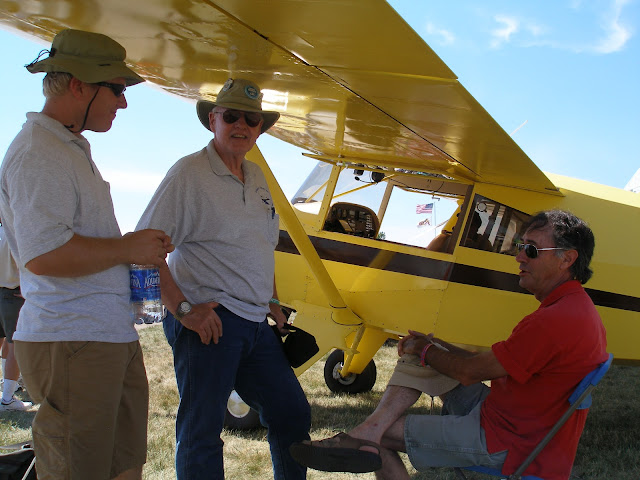
Clint and Larry Vetterman, and Mark Goldberg. Cav has a Vetterman exhaust system, Mark lives at 3R9.
Tuesday I went out to the plane to check the air in the tires. I had checked on Monday (inspecting for problems from the hard landing), and they looked a bit low. In reality they were down a little, but perfectly flyable. But I aired them up and then I was happy that the plane was just right.
Fortunately Tuesday was a reasonably nice day, and I didn't sweat to death taking both wheel pants off to air up the mains.
What's Oshkosh without a huge airplane?
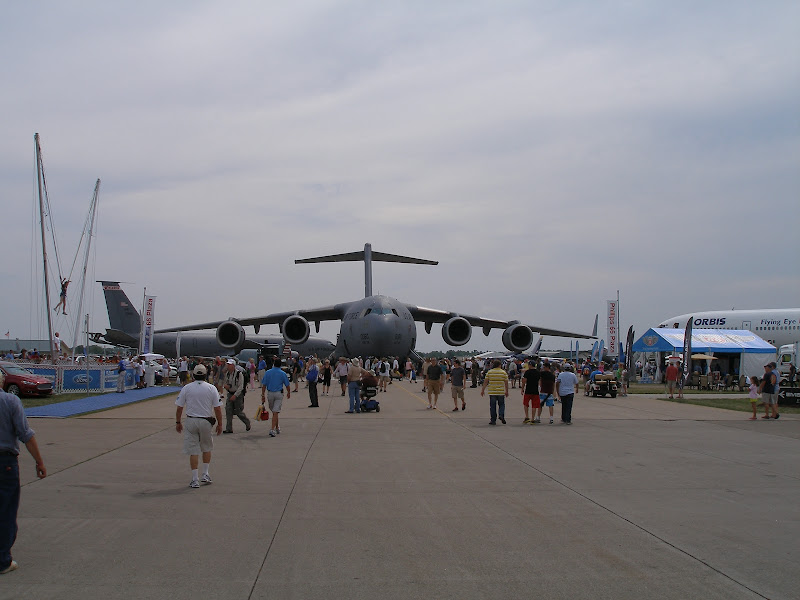

Like this C17 Globemaster that you could live on!
A big attraction of the show this year was the 40th anniversary of Van's Aircraft.
Here are a few pics of the Van's model parade.
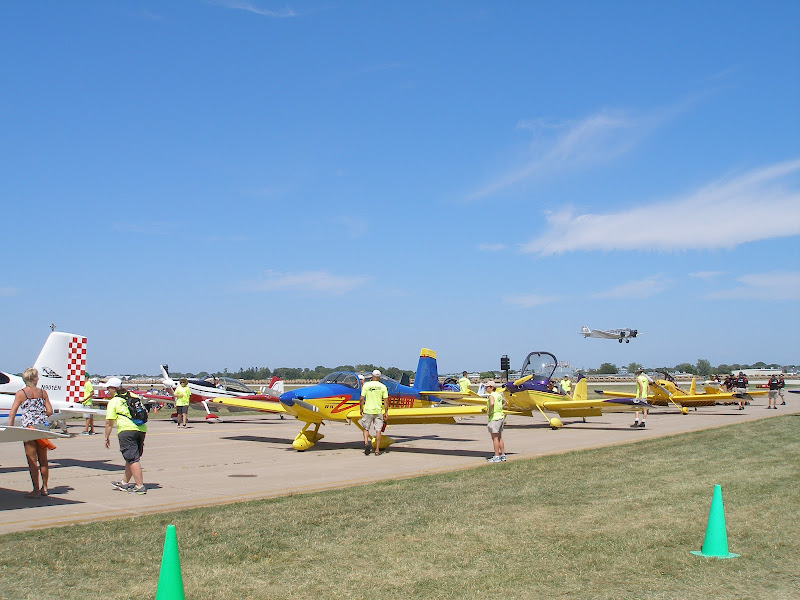

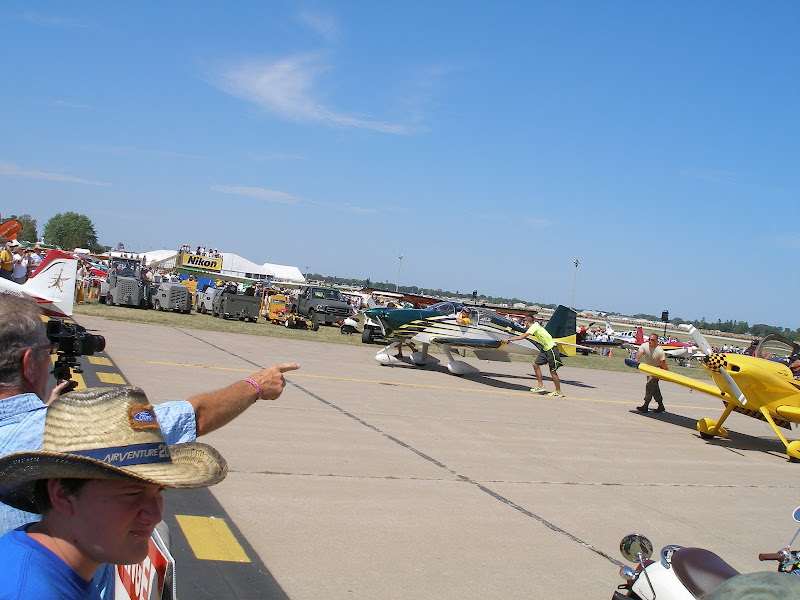
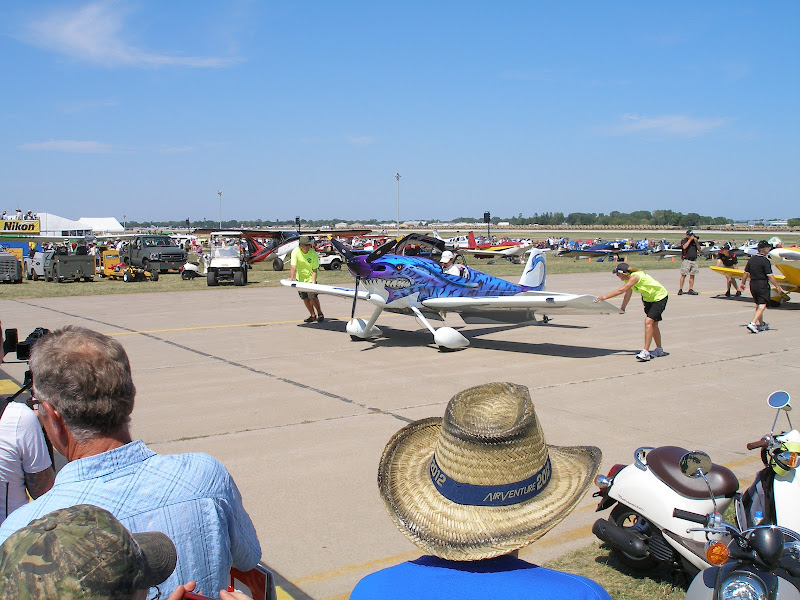
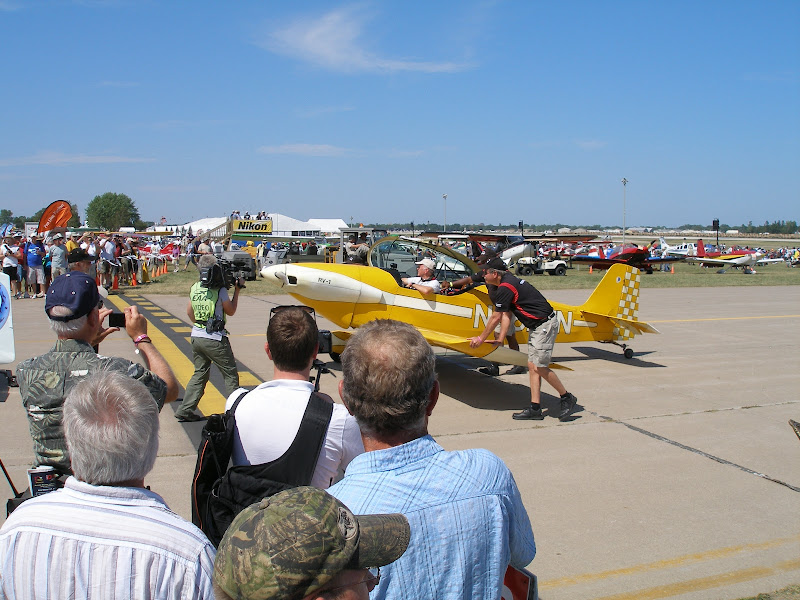
The RV-1, flown by Van himself!
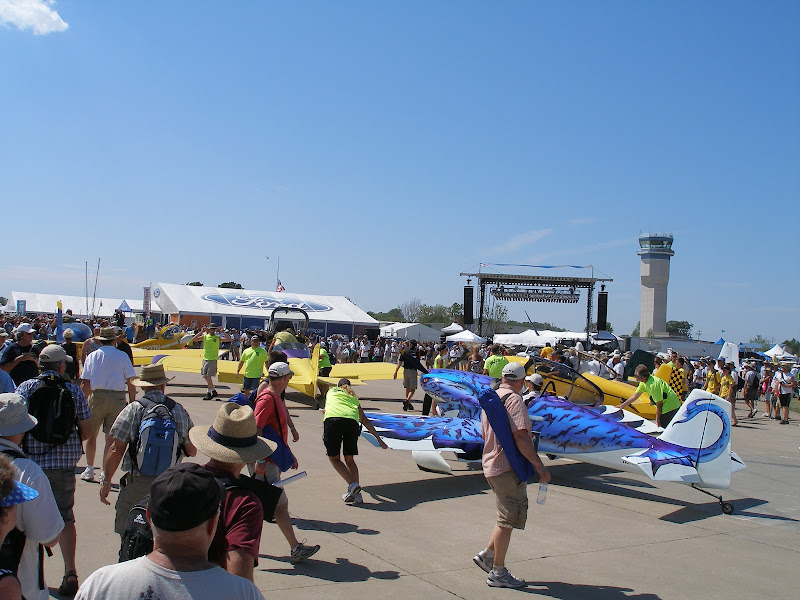
I have to say that even Lynne was impressed with Oshkosh. She'd been to lots of airshows as an AirForce brat, but she was unprepared for the scale and variety of this event. I might even be able to coax her back for another visit!
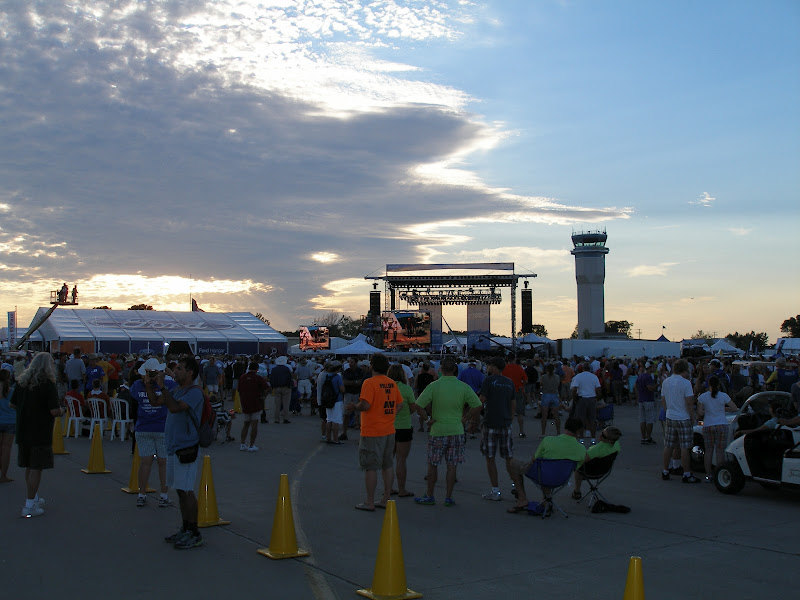
The Steve Miller band Monday evening concert.
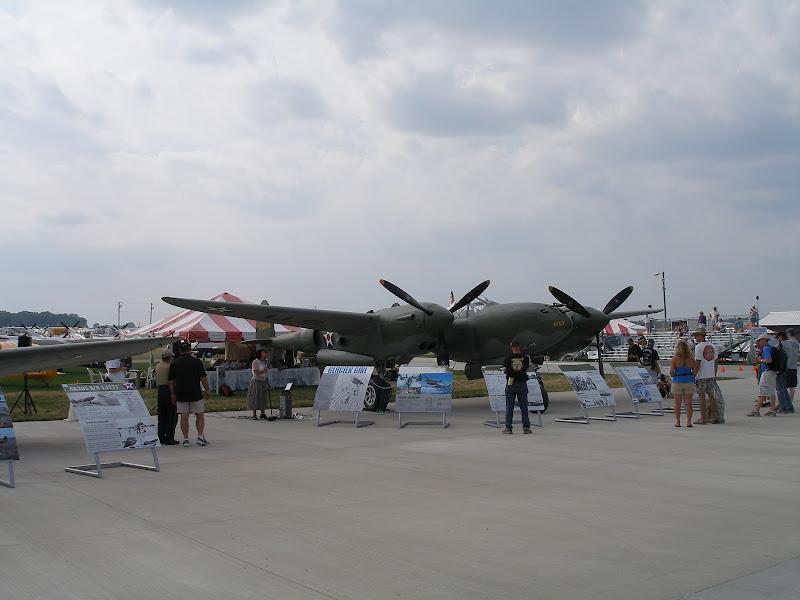
This one's for you Jim!
Monday was ridiculously hot.
I attended a few workshops, one on TIG welding, one on gas welding, and one on fiberglass taught by Sam James. I didn't learn too much in the fiberglass presentation, except that Sam makes it look really easy and he tells really good jokes as he goes.
Clint and Larry Vetterman, and Mark Goldberg. Cav has a Vetterman exhaust system, Mark lives at 3R9.
Tuesday I went out to the plane to check the air in the tires. I had checked on Monday (inspecting for problems from the hard landing), and they looked a bit low. In reality they were down a little, but perfectly flyable. But I aired them up and then I was happy that the plane was just right.
Fortunately Tuesday was a reasonably nice day, and I didn't sweat to death taking both wheel pants off to air up the mains.
What's Oshkosh without a huge airplane?
Like this C17 Globemaster that you could live on!
A big attraction of the show this year was the 40th anniversary of Van's Aircraft.
Here are a few pics of the Van's model parade.
The RV-1, flown by Van himself!
I have to say that even Lynne was impressed with Oshkosh. She'd been to lots of airshows as an AirForce brat, but she was unprepared for the scale and variety of this event. I might even be able to coax her back for another visit!
The Steve Miller band Monday evening concert.
This one's for you Jim!
Oshkosh 2012
On Saturday, July 21, we loaded Cav to max gross weight and took off bound for Wisconsin. We would stay in Appleton, I couldn't find a room close to KOSH.

Leaving Texas behind!
For the trip up we needed to stop for the night somewhere since our room in Appleton wasn't available until Sunday. I chose Davenport, Iowa, a short 1.5 hours from Appleton. I planned for 3r9 KPRX, PGO, KFWB, KDVN, but we changed plans a little and landed first in Fort Smith AR for fuel and and a short break. I made a tactical mistake then, and didn't fill the tanks completely, so we also made a short stop in Hannibal MO before finally arriving at Davenport. Now a days, whenever you change your destination, ATC will ask why you are changing plans. This is part of the new "Homeland Security" paranoia. My default answer will always be "bathroom break". In truth, we had a bit more headwind than I had anticipated, and I just chose to land a little sooner than planned because I get nervous with only an hour and a half of fuel left! Besides, we had plenty of time and it's kind of fun to make spur of the moment decisions. Our actual route was 3r9 kprx pgo kfsm khae keok kdvn.

Table Rock Lake, near Branson MO

Hannibal, Missouri - Home of Sam Clemens
We got a ride to the Best Western in Davenport and had a relaxing evening.
I didn't know quite what to expect going into Appleton on Sunday morning, but my planning worked out perfect. First, I followed the NOTAM procedures and used Lake Butte Des Morts as my "initial approach fix". The only problem with this is we had to fly directly over Ripon, just where all of the KOSH traffic was gathering before flying the FISK arrival into the field. My plan was to be over Ripon at 5500 feet. The weather allowed this and the rest of the arival went flawlessly, with no traffic conflicts at all. ATW wasn't too busy, it was just like flying into any other Class D towered airport. After an ugly bounced landing on 22, we taxied to the south grass parking area, tied down and we took a shuttle to the FBO to pick up our rental car.


This photo taken for Patti's Birthday!
Leaving Texas behind!
For the trip up we needed to stop for the night somewhere since our room in Appleton wasn't available until Sunday. I chose Davenport, Iowa, a short 1.5 hours from Appleton. I planned for 3r9 KPRX, PGO, KFWB, KDVN, but we changed plans a little and landed first in Fort Smith AR for fuel and and a short break. I made a tactical mistake then, and didn't fill the tanks completely, so we also made a short stop in Hannibal MO before finally arriving at Davenport. Now a days, whenever you change your destination, ATC will ask why you are changing plans. This is part of the new "Homeland Security" paranoia. My default answer will always be "bathroom break". In truth, we had a bit more headwind than I had anticipated, and I just chose to land a little sooner than planned because I get nervous with only an hour and a half of fuel left! Besides, we had plenty of time and it's kind of fun to make spur of the moment decisions. Our actual route was 3r9 kprx pgo kfsm khae keok kdvn.
Table Rock Lake, near Branson MO
Hannibal, Missouri - Home of Sam Clemens
We got a ride to the Best Western in Davenport and had a relaxing evening.
I didn't know quite what to expect going into Appleton on Sunday morning, but my planning worked out perfect. First, I followed the NOTAM procedures and used Lake Butte Des Morts as my "initial approach fix". The only problem with this is we had to fly directly over Ripon, just where all of the KOSH traffic was gathering before flying the FISK arrival into the field. My plan was to be over Ripon at 5500 feet. The weather allowed this and the rest of the arival went flawlessly, with no traffic conflicts at all. ATW wasn't too busy, it was just like flying into any other Class D towered airport. After an ugly bounced landing on 22, we taxied to the south grass parking area, tied down and we took a shuttle to the FBO to pick up our rental car.
This photo taken for Patti's Birthday!
Sunday, July 15, 2012
Prop balance
Flew up to Dallas area today, the RV mecca of 52F, to have Walt Aronow balance the prop. The flight up was uneventful, wheels up at 0930 after fueling up, 4500 and 5500 Gooch Springs, Copeland, then Ft. Worth Alliance cleared me to transit their airspace direct to Northwest Regional. Walt's shop was easy to find, thanks to the map on his web page.

We took off the cowling and hooked up transducers to measure movement as the prop is moving. I ran it up to a static RPM of about 2100, manifold pressure of 28.5, and he took one reading. .3 inches/sec, which is out of spec. He added AN3 bolt and nyloc to the flywheel and we ran it up again. Pretty close. He added a final washer to fine tune, and ran it up one more time. He had me run a bit longer, to do the spectrum analysis. End result was .02, in the range that's pretty darned good, .03 is usually good enough. He was also happy with the spectrum, no big harmonic spikes.
After unhooking the balancing equipment, he hooked up a magneto timing box and we had a quick look at ignition timing. It was again, pretty darned close, such that changing it would probably make it worse. So there's another task done for the annual inspection.
We cleaned up and I reinstalled the cowling while he got the paperwork done. About the time I handed him the check, folks started arriving for the next appointment. Walt had a busy day.
He gave hints on how to leave the area, stay below 1500, contact 118.1, and proceed direct below the Class B shelf. Departure actually cleared on course me through Class Bravo if needed, but I kept it below the shelves all the way out.

Fort Worth
About the time I got to the edge of DFW airspace, it became clear that the direct route would not work. There was dark nasty clouds, and heavy rain. I started veering east, eventually going direct to Waco. It appeared to be clear to the Southwest, but dark, towering clouds and heavy rain kept forming at my 3 o'clock position just as fast as I flew south. Convective activity was also flaring to the east.

I finally rounded the corner south of Temple, and skirted west of Georgetown, making a straight into Lakeway, now the only place it wasn't raining or about to. I got through in the nick of time, although it wasn't raining at Lakeway 2 hours later!
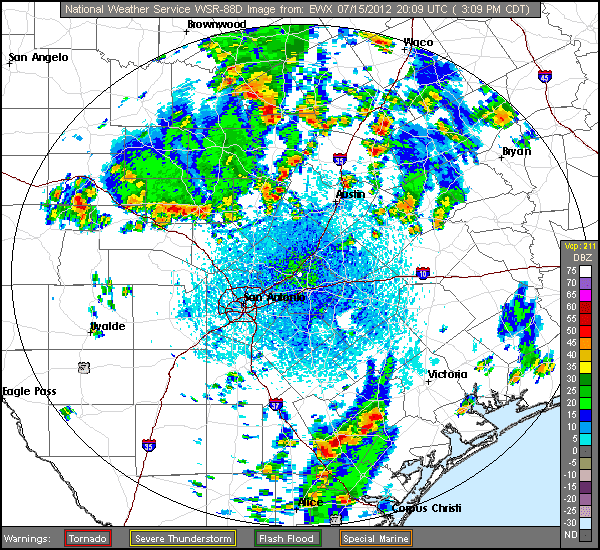
These radar captures are from about an hour after the flight. It was clear from KAFW, KACT, KTPL, KGTU, 3R9, if a bit bumpy.
We took off the cowling and hooked up transducers to measure movement as the prop is moving. I ran it up to a static RPM of about 2100, manifold pressure of 28.5, and he took one reading. .3 inches/sec, which is out of spec. He added AN3 bolt and nyloc to the flywheel and we ran it up again. Pretty close. He added a final washer to fine tune, and ran it up one more time. He had me run a bit longer, to do the spectrum analysis. End result was .02, in the range that's pretty darned good, .03 is usually good enough. He was also happy with the spectrum, no big harmonic spikes.
After unhooking the balancing equipment, he hooked up a magneto timing box and we had a quick look at ignition timing. It was again, pretty darned close, such that changing it would probably make it worse. So there's another task done for the annual inspection.
We cleaned up and I reinstalled the cowling while he got the paperwork done. About the time I handed him the check, folks started arriving for the next appointment. Walt had a busy day.
He gave hints on how to leave the area, stay below 1500, contact 118.1, and proceed direct below the Class B shelf. Departure actually cleared on course me through Class Bravo if needed, but I kept it below the shelves all the way out.
Fort Worth
About the time I got to the edge of DFW airspace, it became clear that the direct route would not work. There was dark nasty clouds, and heavy rain. I started veering east, eventually going direct to Waco. It appeared to be clear to the Southwest, but dark, towering clouds and heavy rain kept forming at my 3 o'clock position just as fast as I flew south. Convective activity was also flaring to the east.

I finally rounded the corner south of Temple, and skirted west of Georgetown, making a straight into Lakeway, now the only place it wasn't raining or about to. I got through in the nick of time, although it wasn't raining at Lakeway 2 hours later!

These radar captures are from about an hour after the flight. It was clear from KAFW, KACT, KTPL, KGTU, 3R9, if a bit bumpy.
Visit from the Past!
So there I am in the hangar, removing the empennage fairing so I can inspect the elevator controls and the VS/HS attach points, when this motorcycle rides down the taxiway in back. At first I think it's one of the regulars, but it's clear it isn't. The motorcycle turns around, he looks at me, and nods yes. He pulls into the driveway, and says, "I figured I have to visit every 20 years or so."
I recognized the voice, and said something like "OMG!". He opens the helmet, and there was Sam C. Lee III, my best friend from high school! We rode and maintained motorcycles as teenagers, and that was a big part of the foundation that allowed me to plunge into building an airplane with zero self doubt.
Sam's family was kind enough to give me a home when I returned alone from Germany to go to UT Austin.
I'd been fretting because I couldn't seem to find him, but it turns out he lives near Lampassas and works in Killeen, not where I was looking.

Sam helped me do the RV-9 HS attach "SB" (adding washers under the bolt heads), we finished up the inspection, put the fairing back on, and went to lunch. The weather was building up, with a nasty cloud to the north, so we opted not to fly. But that gives me great excuse to fly up to Lampassas and checkout the courtesy car!
For July 5, 2012
Oil change. 100W+. Only one small speck of metal in the filter, finger screen was clean. Installed new spark plugs.
I recognized the voice, and said something like "OMG!". He opens the helmet, and there was Sam C. Lee III, my best friend from high school! We rode and maintained motorcycles as teenagers, and that was a big part of the foundation that allowed me to plunge into building an airplane with zero self doubt.
Sam's family was kind enough to give me a home when I returned alone from Germany to go to UT Austin.
I'd been fretting because I couldn't seem to find him, but it turns out he lives near Lampassas and works in Killeen, not where I was looking.
Sam helped me do the RV-9 HS attach "SB" (adding washers under the bolt heads), we finished up the inspection, put the fairing back on, and went to lunch. The weather was building up, with a nasty cloud to the north, so we opted not to fly. But that gives me great excuse to fly up to Lampassas and checkout the courtesy car!
For July 5, 2012
Oil change. 100W+. Only one small speck of metal in the filter, finger screen was clean. Installed new spark plugs.
Saturday, June 16, 2012
Went up this morning to do some high altitude testing and finally try out the oxygen setup. Went very well. The cloud bases were at 5500, the tops at 7500. It was clear in the early morning, but had become scattered to broken by the time I went up at 11. Refueled first, and with ~40 lbs of baggage I was flying at 1500 lbs.

Got up to 8500, set a course at 350, turned on the autopilot and donned the oxygen mask. I have a finger tip pulse/oximeter and used it all during the testing. After leaning the engine I did several cruise measurements, max power, then for 55% power recorded outside temp, manifold pressure, RPM, indicated airspeed,true airspeed, and fuel flow. Then monitored blood oxygen. With oxygen on, I never saw oxygen saturation go below 98%. Then commanded the autopilot to a 400fpm climb, added a bit of power, and went up 1000 ft.. Turned to a 010 heading to keep my heading correct for the cruise altitude of 9500 ft. Then recored the data and monitored oxygen. Repeated this process for up to 14,500 feet. After that, I did a short excursion up to 15000 just to say I did it.
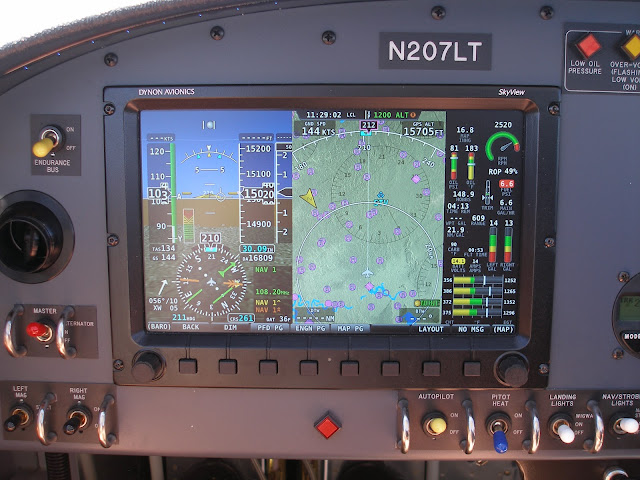
The OAT at the surface was upper 80's, and the pressure at Lago Vista was 30.06 (inches mercury), so density altitudes were about 2000 feet higher than true altitudes. On the way back down, at 11.5, I turned off the oxygen. In about 5 minutes, blood saturation was down to 92%. It's clear that the oxygen system does what it's supposed to! I had to get down to 8500 to get the reading back up to 95%.

It was a fairly nice day at 3R9.
Got up to 8500, set a course at 350, turned on the autopilot and donned the oxygen mask. I have a finger tip pulse/oximeter and used it all during the testing. After leaning the engine I did several cruise measurements, max power, then for 55% power recorded outside temp, manifold pressure, RPM, indicated airspeed,true airspeed, and fuel flow. Then monitored blood oxygen. With oxygen on, I never saw oxygen saturation go below 98%. Then commanded the autopilot to a 400fpm climb, added a bit of power, and went up 1000 ft.. Turned to a 010 heading to keep my heading correct for the cruise altitude of 9500 ft. Then recored the data and monitored oxygen. Repeated this process for up to 14,500 feet. After that, I did a short excursion up to 15000 just to say I did it.
The OAT at the surface was upper 80's, and the pressure at Lago Vista was 30.06 (inches mercury), so density altitudes were about 2000 feet higher than true altitudes. On the way back down, at 11.5, I turned off the oxygen. In about 5 minutes, blood saturation was down to 92%. It's clear that the oxygen system does what it's supposed to! I had to get down to 8500 to get the reading back up to 95%.
It was a fairly nice day at 3R9.
For 6/13/2012
Flew today as Wayne's first passenger! He has his 40 hours done and he was anxious to take someone up. I got the nod since Cora was not feeling well. His airplane, 20WX, an RV-7A quickbuild with a new Lycoming factory IO-390, is superb!
It climbs very well even with the two of us, easily does 150knots indicated, and runs smooth as silk. I keep saying it's like he has an electric motor under the cowling.
Sunday, May 20, 2012
RV visiting hours
Jan Elkjaer, JanRV6UK on the VAF forums, and his son, Aksel, visited today. Jan is building a RV6 back in England, Aksel is just finishing a exchange year at UT. They are about to launch on a trip in a 172 to parts west. They will fly N413ES, a plane I have many hours in.
While they were here they got to see our two flying RV's, ask lots of questions, try the seats out, see two different avionics packages, etc..
As a bonus, Mike Collier had the CAF P-63 King Cobra at the airpark (in a hangar) so we all got to ooh and aah over this awesome aircraft, one of only 3 flying.
Finally, just as the day got good and hot and bumpy, I asked if they wanted to fly. Of course Aksel said yes, so we fueled up and launched in the RV-9A. This was Aksel's first RV time, and first low wing time. He came back and immediately goaded his Dad to finish the 6. Mission accomplished!
Lynne and I flew to KJWY, Midlothian/Waxahachie to visit Katrin at the Scarborough Fair renaissance festival. Didn't take any pictures, but we had a nice "Courtesy Car Adventure" in a retired Waxahachie police Crown Vic. Old and beat up, but the A/C worked!
May 27, 2012
We also flew up to Arkansas and landed at Mena to go hiking for the day in the Ouchita National Forest.

The hiking was hot and windy, and not all that great, but we both got a kick out of using the RV to get out of Texas for the day!
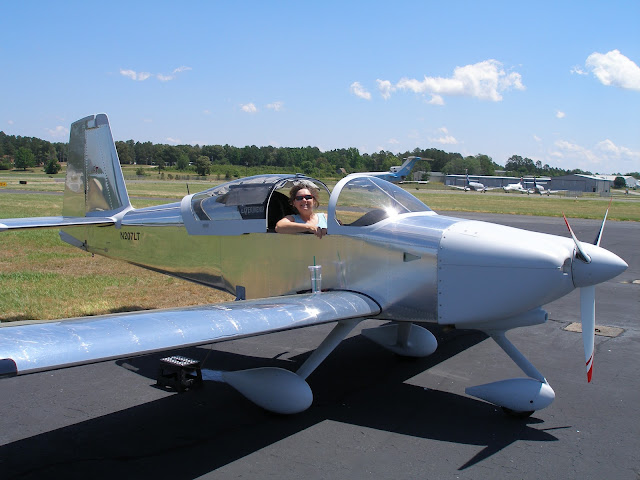
We had another "Courtesy Car Adventure" thanks to the nice folks at the FBO. It was an older car in serious need of new brake rotors and other front end work. The check engine and low coolant lights were always on. I wasn't sure it could be trusted in the mountains of Ouchita National Park, but it got us there and back.
May 27, 2012
We also flew up to Arkansas and landed at Mena to go hiking for the day in the Ouchita National Forest.
The hiking was hot and windy, and not all that great, but we both got a kick out of using the RV to get out of Texas for the day!
We had another "Courtesy Car Adventure" thanks to the nice folks at the FBO. It was an older car in serious need of new brake rotors and other front end work. The check engine and low coolant lights were always on. I wasn't sure it could be trusted in the mountains of Ouchita National Park, but it got us there and back.
After 130 hours and about 180 landings, my main tires are noticeably worn on the outside edge. So I decided to rotate the tires. On a car you move a tire from one location to another, but that would be pointless in this application. In this case rotate means to leave the tire in the same place but turn it around. Now the worn part is on the inside edge, and the outside edge has lots of tread to start wearing down.

After rotating the tire, the worn part is on the inside.
The process is fairly simple. First, remove the wheel fairings, then jack up a main wheel. I attached a hose clamp to the gear leg to give my floor jack a place to grab. This worked very well. I added a small strip of .032 AL on the second wheel to protect the gear leg better.

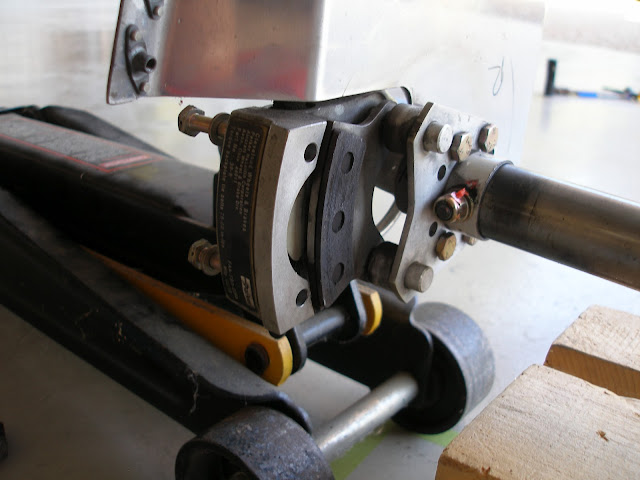
With the wheel off the ground, remove the outside brake caliper, the axle nut cotter pin, and the axle nut. Then the main wheel can be removed. Then deflate the inner tube and pop the tire beads off the hub rims. Next remove the three bolts holding the hub halves together. Split the hub and remove both halves. Remove the inner tube. Reinstall the inner tube in the other direction, so the the tire will now be rotating in the other direction, with the worn tread toward the centerline of the plane.
Assembly is the reverse.
It turned out to be easy to avoid pinching the inner tube when reassembling, with just a little air, the tube assumed a shape that kept it well clear of the hub halves. I did repack the wheel bearings, although there was no need to quite yet. With the wheels off it's a good idea to inspect the brakes. The pads all had enough life to make to annual time, although the rigth inner pad had a bit more wear than the others. I ordered three sets of pads to keep Wayne and I in the air for a few years.
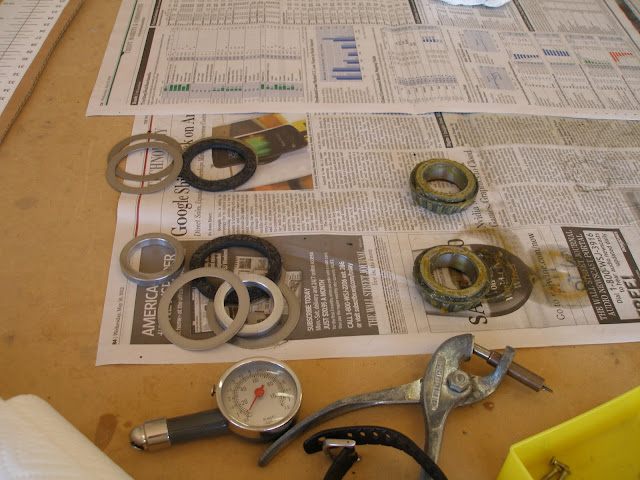
I also ordered the high temp V75 -218 orings for the next time the brakes are disassembled. In all the left main took about 3 hours, and the right main about 2 hours. The worst part about the job is removing and installing the wheel fairings. That's just difficult uncomfortable work.
After rotating the tire, the worn part is on the inside.
The process is fairly simple. First, remove the wheel fairings, then jack up a main wheel. I attached a hose clamp to the gear leg to give my floor jack a place to grab. This worked very well. I added a small strip of .032 AL on the second wheel to protect the gear leg better.
With the wheel off the ground, remove the outside brake caliper, the axle nut cotter pin, and the axle nut. Then the main wheel can be removed. Then deflate the inner tube and pop the tire beads off the hub rims. Next remove the three bolts holding the hub halves together. Split the hub and remove both halves. Remove the inner tube. Reinstall the inner tube in the other direction, so the the tire will now be rotating in the other direction, with the worn tread toward the centerline of the plane.
Assembly is the reverse.
It turned out to be easy to avoid pinching the inner tube when reassembling, with just a little air, the tube assumed a shape that kept it well clear of the hub halves. I did repack the wheel bearings, although there was no need to quite yet. With the wheels off it's a good idea to inspect the brakes. The pads all had enough life to make to annual time, although the rigth inner pad had a bit more wear than the others. I ordered three sets of pads to keep Wayne and I in the air for a few years.
I also ordered the high temp V75 -218 orings for the next time the brakes are disassembled. In all the left main took about 3 hours, and the right main about 2 hours. The worst part about the job is removing and installing the wheel fairings. That's just difficult uncomfortable work.
N20WX flies!
A very belated post. At the end of March, Wayne pushed his project into airworthy condition, and earned a passing grade from the San Antonio FSDO. N20WX is a airplane.
He made the first flight on April 1.
His IO-390 powered RV-7A runs smooth and sounds awesome.
As I type this 45 days later, he has over 20 hours and is doing final install of the gear fairings. He will definitely be ready to go to Oshkosh.
Wednesday, March 14, 2012
Final Leg
I woke up on the 12th to these METARS.
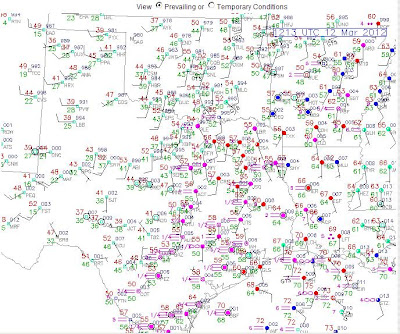
The pink and red mean I can't legally fly there.
While forecast and expected, I was bummed to see a low overcast sky out the window. I was tired of being held captive in the Hilton. The forecast was for this to lift by 11, and that's what happened. So I checked out and got the hotel shuttle to take me to KDTN.
There I retreived the plane, refueled, and then waited. The sky was definitely clearing up, and the 10:53 METAR update showed green and blue for the route. I saddled up and said goodby to Shreveport.
The flight home was uneventful, although Austin was reporting IFR until just as I got there. The AWOS from Rusty Allen was reporting "sky clear below one two thousand", so I knew I'd be able to get into Lakeway. The conditions along the way were clear to scattered, with some stations reporting a ceiling at 900 ft.

The pink and red mean I can't legally fly there.
While forecast and expected, I was bummed to see a low overcast sky out the window. I was tired of being held captive in the Hilton. The forecast was for this to lift by 11, and that's what happened. So I checked out and got the hotel shuttle to take me to KDTN.
There I retreived the plane, refueled, and then waited. The sky was definitely clearing up, and the 10:53 METAR update showed green and blue for the route. I saddled up and said goodby to Shreveport.
The flight home was uneventful, although Austin was reporting IFR until just as I got there. The AWOS from Rusty Allen was reporting "sky clear below one two thousand", so I knew I'd be able to get into Lakeway. The conditions along the way were clear to scattered, with some stations reporting a ceiling at 900 ft.
Sunday, March 11, 2012
Return from Virginia, or Stuck in Shreveport again
And now a post on the return flight. As I type this I'm stuck in the Hilton in downtown Shreveport, Louisiana. It's raining, and will all day, so I can't even go walking anywhere.
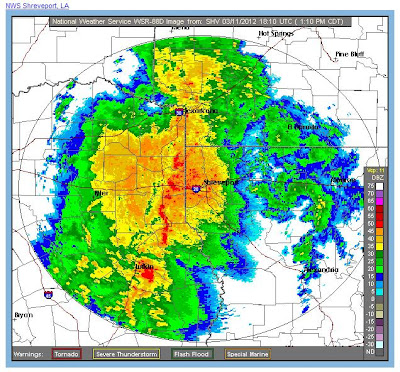
So while I was deleting old browser favorites (sort of like cleaning out the sock drawer), I realized I needed to write up a trip report. What a great way to kill a few minutes! With what looks like a whole day to kill, I'm going to use a lot of words!
As soon as I arrived in Virgnia, I started keeping an eye on the weather to see when a return might be possible. As much as I would like to stay out there for a couple of weeks, I still need to get some work-work done so I can pay for Avgas. I was shooting for returning for the weekend, and the forecast hinted that Sunday might be a good day.
I wasn't paying attention, Friday would have been OK, if windy, but I didn't want to go home that soon anyway. But by Friday evening, the situation was shaping up to be problematic. The weather in Austin would be clear on Saturday morning, and Monday, but lousy every other day in the 10 day forecast. There would be no way, after Friday, of making it home in one day. And it got worse. A slow moving low was forming over south Texas, forecast to grow and cover the entire central US. There was no way to avoid it by flying around to the north.
Saturday morning I woke up and hit the weather pages. It turned out to be clear all the way to east Texas, but was already marginal in Austin. It was either go now and get part way, or be in Virginia for another week. I quickly decided to go, got packed and ready, and Dad drove me to the airport in Culpepper.
My initial plan was to get to southern Arkansas, and I called the number at KLLQ, Monticello, and talked to the manager who was very helpful. Fuel and hotels were available, a car, and he allowed the use of a partially enclosed T hangar.
The wind had been howling for three days, but the plane was in good shape. The control locks all worked as designed. I got fuel, preflighted, paid the tie down tab, and said goodbye to Dad. It took a few tries to start up the cold engine, but it came alive without running the battery down.
There were other people in the pattern so the CTAF was a little busy. I did my warm up and runup, then launched. Climbing out of pattern altitude (1000 ft above the ground), I smelled fuel. This used to happen with full tanks when I first started flying, but I had found the issue and solved it. I hadn't smelled any fuel since then, so this was unusual. I decided to return to the field to see what was going on. I wondered if Dad had seen me return and it turned out he did.
On the ground I found no evidence of the problem, chocked it up to full tanks and the vent lines interacting with airflow at high angles of attack. I departed again and once in a more level attitude there was no more fuel smell. The smell returned at that next fuel stop, but the story was the same, it was only there for the initial steep climb, then went away. I will look at this closely when I get home, I'm betting there is a loose nut on the vent lines somewhere.
My route of flight was KCJR, 8A3, KLLQ. The flight over the mountains was reasonbly smooth at 8500 feet, but a bit nerve wracking. For two hours there are few decent places to put down if needed. But the fan kept turning and then soon the mountains were behind me and I was descending for Livingston Muni, a non-controlled airport. They had fuel, a bathroom, and a computer with internet service, everything a transient pilot needs.
Soon I was on my way again, funky fuel smell problem and all. The rest of the flight was pretty uneventful. As I got to Memphis, there was a big fire. From a distance I thought it was clouds, but soon realized it was smoke. It looked to be higher than my 8500 ft so I started to deviate, but I flew over the top with plenty to spare. It was the topic conversation with Memphis Approach and other pilots.

Once past the smoke, it was obviously VFR as far as I could see. I informed Memphis Center that my destination was changing to Minden, LA. I had once run a triathlon there. The sky started to darken approaching Minden, but I could see Shreveport, so I made my final change to Shreveport Downtown. The landing was smooth, and I taxied up Millen Aire. The line guy met me and he quickly found a hangar for the plane.
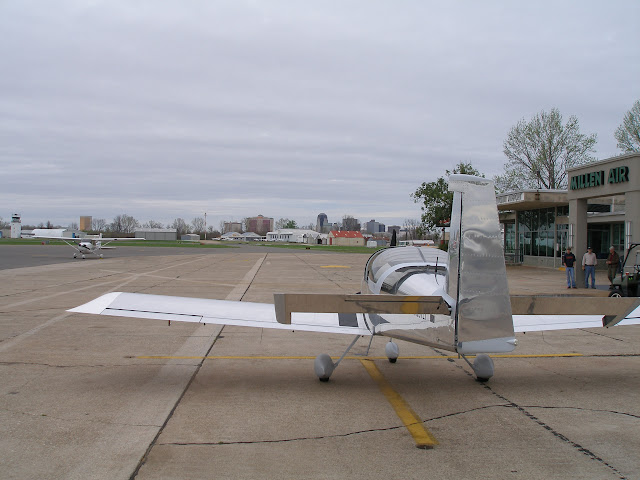
There were a few people on the ramp and they asked if they could look at the plane. Of course I said yes. They were sponsoring a Boy Scount merit badge event, and I was happy to have one of the boys look at the plane and ask questions. He was just about to get his turn in a 172 they were flying. I hope my plane served as a bit of inspiration for him.
Then I followed the line guy to the other side of the field to the hangar. We had move one plane to get Cav in, but there she was, a nice cozy place to wait out the storm. While we were putting the plane the hangar, one of the locals went up for some practice in his Extra 300. So we got to watch an air show act for free!
Back at the FBO office, the guys called around to find a room for me. The casinos might have been OK, but since it was spring break, they were booked solid. They found a room at the Hilton, which was pricey, but acceptable. I was really happy with the service at Millen Aire, this is an FBO worth supporting.
So here I am sitting in the Hilton. I've been watching the weather all day and it looked like it would just clear enough for a return just as my launch window would close. I would need to be calling tower for departure at 5:30 to make it home to Lakeway before sunset.
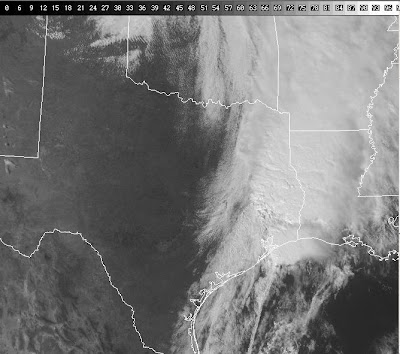
This system had started to move, and a rough calculation showed the edge would be very close to DTN by 5:30.
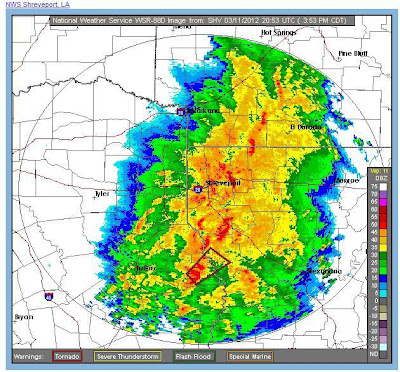
And here the rain is nearly over in Shreveport
Sure enough, right on queue. It had been VFR here in Shreveport for almost 2 hours already, but with marginal and IFR to the east. I was very tempted to go wait at the airport for it to clear and then launch as soon as the METARS showed suitable weather. But it turned out to be a false window. These METARS reveal that there was still bad conditions on the route.

So while I was deleting old browser favorites (sort of like cleaning out the sock drawer), I realized I needed to write up a trip report. What a great way to kill a few minutes! With what looks like a whole day to kill, I'm going to use a lot of words!
As soon as I arrived in Virgnia, I started keeping an eye on the weather to see when a return might be possible. As much as I would like to stay out there for a couple of weeks, I still need to get some work-work done so I can pay for Avgas. I was shooting for returning for the weekend, and the forecast hinted that Sunday might be a good day.
I wasn't paying attention, Friday would have been OK, if windy, but I didn't want to go home that soon anyway. But by Friday evening, the situation was shaping up to be problematic. The weather in Austin would be clear on Saturday morning, and Monday, but lousy every other day in the 10 day forecast. There would be no way, after Friday, of making it home in one day. And it got worse. A slow moving low was forming over south Texas, forecast to grow and cover the entire central US. There was no way to avoid it by flying around to the north.
Saturday morning I woke up and hit the weather pages. It turned out to be clear all the way to east Texas, but was already marginal in Austin. It was either go now and get part way, or be in Virginia for another week. I quickly decided to go, got packed and ready, and Dad drove me to the airport in Culpepper.
My initial plan was to get to southern Arkansas, and I called the number at KLLQ, Monticello, and talked to the manager who was very helpful. Fuel and hotels were available, a car, and he allowed the use of a partially enclosed T hangar.
The wind had been howling for three days, but the plane was in good shape. The control locks all worked as designed. I got fuel, preflighted, paid the tie down tab, and said goodbye to Dad. It took a few tries to start up the cold engine, but it came alive without running the battery down.
There were other people in the pattern so the CTAF was a little busy. I did my warm up and runup, then launched. Climbing out of pattern altitude (1000 ft above the ground), I smelled fuel. This used to happen with full tanks when I first started flying, but I had found the issue and solved it. I hadn't smelled any fuel since then, so this was unusual. I decided to return to the field to see what was going on. I wondered if Dad had seen me return and it turned out he did.
On the ground I found no evidence of the problem, chocked it up to full tanks and the vent lines interacting with airflow at high angles of attack. I departed again and once in a more level attitude there was no more fuel smell. The smell returned at that next fuel stop, but the story was the same, it was only there for the initial steep climb, then went away. I will look at this closely when I get home, I'm betting there is a loose nut on the vent lines somewhere.
My route of flight was KCJR, 8A3, KLLQ. The flight over the mountains was reasonbly smooth at 8500 feet, but a bit nerve wracking. For two hours there are few decent places to put down if needed. But the fan kept turning and then soon the mountains were behind me and I was descending for Livingston Muni, a non-controlled airport. They had fuel, a bathroom, and a computer with internet service, everything a transient pilot needs.
Soon I was on my way again, funky fuel smell problem and all. The rest of the flight was pretty uneventful. As I got to Memphis, there was a big fire. From a distance I thought it was clouds, but soon realized it was smoke. It looked to be higher than my 8500 ft so I started to deviate, but I flew over the top with plenty to spare. It was the topic conversation with Memphis Approach and other pilots.
Once past the smoke, it was obviously VFR as far as I could see. I informed Memphis Center that my destination was changing to Minden, LA. I had once run a triathlon there. The sky started to darken approaching Minden, but I could see Shreveport, so I made my final change to Shreveport Downtown. The landing was smooth, and I taxied up Millen Aire. The line guy met me and he quickly found a hangar for the plane.
There were a few people on the ramp and they asked if they could look at the plane. Of course I said yes. They were sponsoring a Boy Scount merit badge event, and I was happy to have one of the boys look at the plane and ask questions. He was just about to get his turn in a 172 they were flying. I hope my plane served as a bit of inspiration for him.
Then I followed the line guy to the other side of the field to the hangar. We had move one plane to get Cav in, but there she was, a nice cozy place to wait out the storm. While we were putting the plane the hangar, one of the locals went up for some practice in his Extra 300. So we got to watch an air show act for free!
Back at the FBO office, the guys called around to find a room for me. The casinos might have been OK, but since it was spring break, they were booked solid. They found a room at the Hilton, which was pricey, but acceptable. I was really happy with the service at Millen Aire, this is an FBO worth supporting.
So here I am sitting in the Hilton. I've been watching the weather all day and it looked like it would just clear enough for a return just as my launch window would close. I would need to be calling tower for departure at 5:30 to make it home to Lakeway before sunset.
This system had started to move, and a rough calculation showed the edge would be very close to DTN by 5:30.
And here the rain is nearly over in Shreveport
Sure enough, right on queue. It had been VFR here in Shreveport for almost 2 hours already, but with marginal and IFR to the east. I was very tempted to go wait at the airport for it to clear and then launch as soon as the METARS showed suitable weather. But it turned out to be a false window. These METARS reveal that there was still bad conditions on the route.
Subscribe to:
Posts (Atom)